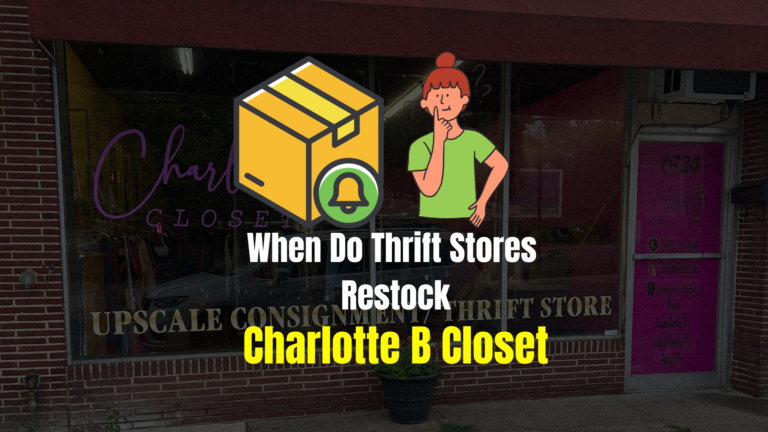Do Thrift Stores Throw Away Clothes – Unravel The Truth
Many people wonder, “Do thrift stores throw away clothes?” The thrift store industry is not just about selling second-hand clothes; it’s a complex network of sustainability, community support, and waste reduction.
However, it’s essential to understand the journey of donated items from the moment they’re handed over to their eventual fate. Do these stores toss out clothes?
Thrift stores, including Goodwill, primarily dispose of clothes that are wet or significantly soiled. Simultaneously, many stores adopt advanced, sustainable methods for managing unsold donations, such as upcycling and textile-to-textile recycling programs.
Do Thrift Stores Throw Away Clothes – A Brief Guide
Thrift stores, integral to eco-friendly shopping and waste reduction, don’t simply toss aside every piece they receive. Indeed, while some well-known establishments like Goodwill might dispose of items that arrive in unsellable conditions, such as being wet or heavily soiled, many stores have implemented strategies to handle the overflow of donations. From rotating stock to ingenious upcycling workshops and even forward-thinking textile recycling initiatives, the primary goal is always to extend the lifecycle of each garment. By understanding these processes, we can make more informed choices as donors and consumers, supporting a future where fashion meets sustainability.
How Do Thrift Stores Handle Unsellable Clothing?
Thrift stores play a crucial role in community sustainability, promoting reuse and reducing waste.
They operate by accepting donations from the public and then reselling these items at significantly reduced prices.
The foundation of thrift stores is built upon the act of giving, where one person’s unwanted item can become another’s treasure.
The revenue generated usually goes towards charitable causes, making it a win-win for the community and the environment.
However, the donations they receive vary in quality, and stores have set guidelines to determine what they can sell and what they cannot.
Goodwill’s Approach
Goodwill, one of the most recognized names in the thrift store industry, sets a precedent for many smaller stores.
They operate with a specific acceptance policy that is rooted in both practicality and safety.
One of the primary rules in their donation policy is the rejection of textiles that are either wet or heavily soiled.
Such items pose a health risk, and they can also damage other items when stored. So, while the Goodwill model is built on accepting a broad range of items, it’s essential to understand that not everything can be repurposed for sale.
Practices of Other Notable Thrift Stores
While Goodwill is a significant player in the thrift industry, numerous other stores operate either on a local or national scale.
These stores, such as The Salvation Army or local community thrift shops, often have their own set of guidelines influenced by their storage capacity, the volume of donations, and their target market.
Some might have stricter guidelines due to limited space, while others, particularly larger ones with multiple outlets, might redistribute items across their stores.
The common denominator, however, is a commitment to sustainability and a preference for items that can be resold.
Emerging Solutions for Unsold Donated Goods
In the face of increasing waste and the challenges of unsold inventory, innovative solutions are emerging in the thrift store industry.
One such initiative is the scalable, traceable, and circular approach to unsold items. Rather than discarding them, efforts are being made to repurpose these goods:
- Repairing Donated Items: Some thrift stores are collaborating with local artisans and tailors to mend donated clothes. This not only gives items a second chance but also supports local businesses.
- Upcycling Programs: Upcycling is the art of transforming old items into something new and valuable. Creative workshops are being set up, where old textiles are turned into bags, accessories, or even art pieces. These transformed items often find a unique market niche appealing to eco-conscious consumers.
- Textile-to-Textile Recycling Projects: Recognizing the environmental impact of textile waste, some thrift stores are pioneering recycling projects where old fabrics are processed and converted into new textiles. This innovative approach ensures that even if an item isn’t fit for resale in its current state, its fabric can be given a new life.
The thrift store industry, with its roots in sustainability, continues to evolve, pushing boundaries in its quest to reduce waste and promote a more circular economy.
What Happens to Donated Clothes at Thrift Stores?
When you donate clothes to thrift stores, they embark on a journey that may see them rehomed, recycled, or, in some cases, discarded. Behind the scenes, thrift stores have established processes that determine the fate of each item.
Sorting Process
Upon arrival, every piece of clothing is meticulously inspected by trained staff. This sorting process categorizes items based on quality, usability, and demand.
While some clothes are immediately identified as sellable, others might be marked for recycling due to minor damages or wear.
Unfortunately, clothes that are soiled, wet, or excessively damaged might be deemed unfit for any purpose and discarded.
On The Shelf
After sorting, items selected for resale are priced. The pricing often takes into account the brand, condition, and potential demand.
These items are then neatly arranged on store shelves, ready to be discovered by bargain hunters and thrift enthusiasts.
Presentation plays a key role, so stores ensure clothes are displayed in a manner that appeals to customers.
Unsold Items
- Rotating stock: Not every item finds a buyer immediately. Items that remain unsold for a specified period — often several weeks to a couple of months — are typically removed from the shelves to make room for fresh stock.
- Redistribution: Rather than discarding these unsold clothes, many larger thrift chains redistribute them to other store locations or even send them overseas where they might find a market.
- Recycling and Repurposing: Clothes that don’t find a home might be repurposed. This can mean turning them into rags or using them as raw materials for other textile-based products.
- Disposal: In situations where clothes can’t be sold, redistributed, or repurposed, they might be responsibly discarded, ensuring minimal environmental impact.
What Type of Clothes Do Thrift Stores Accept?
Thrift stores play a pivotal role in promoting sustainable consumer habits. However, to maintain their operational standards and meet consumer expectations, they have specific guidelines concerning the type of clothing they accept.
General Guidelines
Most thrift stores welcome clean, gently used clothing. Whether it’s casual wear, formal attire, or even accessories, as long as they’re in good condition, they’re likely to be accepted. Seasonality can also play a role; for instance, coats might be in higher demand during winter, while summer wear would be preferred in warmer months.
Unacceptable Donations
While thrift stores are grateful for every donation, certain items are typically declined. This includes clothes that are wet, soiled or have severe damage. Clothing items that have been recalled or do not meet safety standards might also be rejected.
Specialty and Boutique Sections
Some thrift stores, recognizing the value of designer or vintage pieces, have specialty sections dedicated to high-end or unique items. These boutique sections cater to discerning shoppers looking for luxury at a fraction of the original price.
Encouraging Sustainable Donations
Thrift stores often provide donors with guidelines and tips to ensure the donations have the maximum impact. Donors are encouraged to give items that are clean, undamaged, and are likely to find a second home. By donating thoughtfully, individuals play a part in the broader mission of sustainability and community support that thrift stores champion.
Conclusion
Thrift stores have become pillars of sustainability and community support, going beyond merely selling second-hand items.
They diligently sort, display, and even repurpose the clothing they receive. The donation guidelines they follow and the initiatives they employ showcase their commitment to minimizing waste and maximizing the use of resources.
While certain items may indeed be discarded, the overarching aim is to find a new purpose for every piece, be it through sale, repair, upcycling, or recycling.
As donors and shoppers, understanding these processes allows us to contribute more effectively to the cycle of reuse and sustainability.
FAQs
Do thrift stores have specific criteria for discarding donated clothes?
Yes, thrift stores often discard clothes that are wet, heavily soiled, or pose safety concerns, prioritizing items that are sellable and in good condition.
How do thrift stores handle excessive stock of unsold clothes?
Many stores rotate out older stock, redistribute to other locations, or partner with organizations for redistribution, minimizing wastage.
Are there eco-friendly alternatives in thrift stores for unsold clothes?
Yes! Thrift stores are increasingly adopting upcycling and textile-to-textile recycling initiatives to repurpose unsold garments.
How do thrift store practices vary between larger chains like Goodwill and local stores?
While large chains might have more resources for redistribution, local stores may rely more on community collaborations and might have tighter space constraints.

Hi there, I’m Toni Whitten, but you might know me as LadyT. I’m a passionate entrepreneur and the proud owner of Charlotte B’s Closet, your go-to thrift store and upscale consignment.
Outside the store, I connect with the amazing women in my exclusive Facebook group, Housewives of Baltimore, boasting over 23k+ members.
In my free moments, I channel my passion for sharing genuine insights and helpful guides on various concerns through my blog at charlottebcloset.com.







